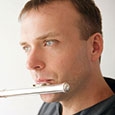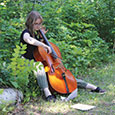Question: In studio class the professor makes us introduce ourselves and describe the piece we are playing. I get so nervous doing this. What can I do to speak more confidently in public?
Answer: Verbally introducing yourself to the audience is an opportunity to connect with your listeners, a skill that will serve you well as a music performer or educator. As audiences become increasingly more selective in their choices to attend performances, your speaking skills can be a vital component of what makes a performance memorable. The human voice is an intimate vehicle that holds the power to enhance an artist’s connection to listeners. Your professor is giving you an excellent opportunity to practice this in studio class. Sparkling, confident speaking is quite similar to sparkling, confident flute performance. Here are a few suggestions that may be helpful.
Make soft eye contact with the audience when speaking. Depending on the size and acoustics of the room, you may need to adjust elements of your introduction, for instance the tempo, volume, or vocal inflection. Usually in a formal situation, one should speak slightly slower with extra projection. Maintain a confident posture. Warm up your voice before the performance. Remember that what you are saying is as important as how you are saying it. Deliver your words as if you are speaking to a friend to reinforce a connection to the audience. Stay hydrated so your voice functions at maximum capacity. The audience will be able to tell if you are not comfortable, so keep practicing until you feel prepared.
Be brief and clear with your words. Listeners have come to hear you play flute not recite an epistle, so give them a short snippet. Announce your name followed by one interesting fact about yourself, or in the case of studio class, your academic year and degree. Don’t forget to introduce any other musicians performing with you. Proclaiming “I will be performing Poulenc’s Sonata for Flute” is both incorrect and neglectful of your accompanist.
State the name of the piece and the composer. Be sure to check pronunciations of unique words. In some cases, this is enough of an introduction. However, most of the time I choose to tell the audience something about the piece, composer, or my experiences preparing the piece. Be intentional and fascinating with this. I take into account who is in the audience when determining how to configure this statement. Listeners like to be part of the inside scoop but avoid telling them things they already know.
You may want to take a moment to educate if you have a younger or non-musically trained audience but keep it brief. At one of my recent studio recitals, an older student was presenting a Bach flute sonata so she explained to an audience of younger students and their families, “Listen to the masterful conversation between the flute and piano.” It made the performance quite magical for everyone.
Of course, to come up with a compelling introduction of the piece, you will need to research the piece and composer, exploring the piece as fully as possible, much in the same way you would do for writing program notes. The first few times you introduce a performance, you may want to write out the exact words you are going to say and then rehearse them like an actor would rehearse a script.
Practice speaking your introduction in a mirror or for a good friend or your teacher who can give you honest feedback. Video or audio record yourself, so you can evaluate yourself. Watch the video recording without sound to evaluate body language. I do this for my flute performances as well. It is important to both look and sound confident on stage. You may even want to watch a few skilled performers on YouTube announce their pieces to gain insight into how they navigate through introductions. The next time you are at a live performance of any kind, observe how the performers vocally interact with the audience.
If you should feel nervousness coming on while speaking, take a deep breath. This will engage the parasympathetic nervous system which induces calmness. Nervousness is just one of the many manifestations of fear that show up in the lives of artists. A little bit of nervousness means that you care about your performance, so send that energy into your performance. Just make sure nervousness sits in the back seat of your car. Do not let it drive the vehicle. The more you practice, the less nervous you will be. Hopefully your excitement about the piece will soon overcome any residual fear.
Additionally, if you want to further refine your public speaking skills, consider taking a semester of speech, acting, or voice lessons to develop more confidence. There is an art to speaking eloquently on stage that can be developed with further study, not entirely different from how you improve your flute skills. Experts in these field have much to say about perfecting the art of public speaking in their books and podcasts.






